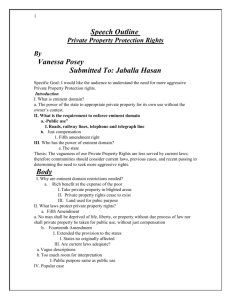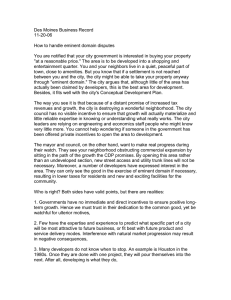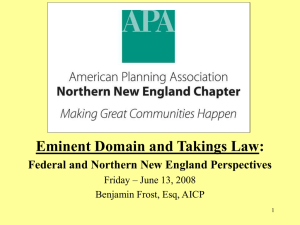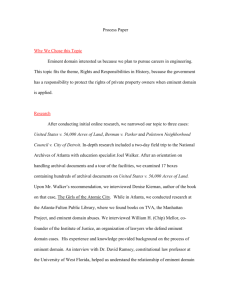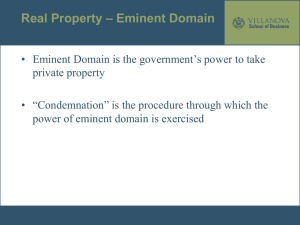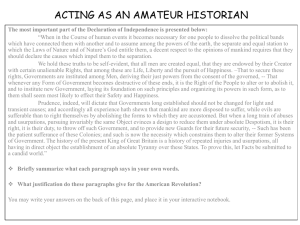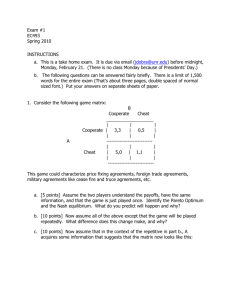GENERAL INFORMATION & TBD
advertisement
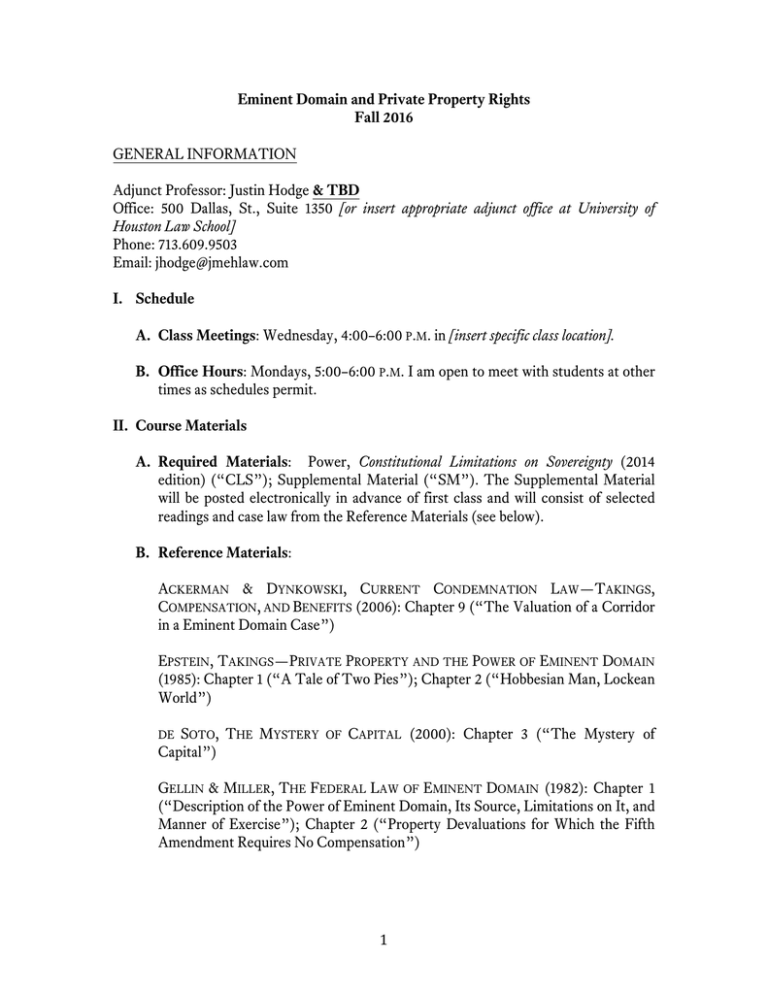
Eminent Domain and Private Property Rights Fall 2016 GENERAL INFORMATION Adjunct Professor: Justin Hodge & TBD Office: 500 Dallas, St., Suite 1350 [or insert appropriate adjunct office at University of Houston Law School] Phone: 713.609.9503 Email: jhodge@jmehlaw.com I. Schedule A. Class Meetings: Wednesday, 4:00–6:00 P.M. in [insert specific class location]. B. Office Hours: Mondays, 5:00–6:00 P.M. I am open to meet with students at other times as schedules permit. II. Course Materials A. Required Materials: Power, Constitutional Limitations on Sovereignty (2014 edition) (“CLS”); Supplemental Material (“SM”). The Supplemental Material will be posted electronically in advance of first class and will consist of selected readings and case law from the Reference Materials (see below). B. Reference Materials: ACKERMAN & DYNKOWSKI, CURRENT CONDEMNATION LAW—TAKINGS, COMPENSATION, AND BENEFITS (2006): Chapter 9 (“The Valuation of a Corridor in a Eminent Domain Case”) EPSTEIN, TAKINGS—PRIVATE PROPERTY AND THE POWER OF EMINENT DOMAIN (1985): Chapter 1 (“A Tale of Two Pies”); Chapter 2 (“Hobbesian Man, Lockean World”) SOTO, THE MYSTERY Capital”) DE OF CAPITAL (2000): Chapter 3 (“The Mystery of GELLIN & MILLER, THE FEDERAL LAW OF EMINENT DOMAIN (1982): Chapter 1 (“Description of the Power of Eminent Domain, Its Source, Limitations on It, and Manner of Exercise”); Chapter 2 (“Property Devaluations for Which the Fifth Amendment Requires No Compensation”) 1 MERRIAM & ROSS, EMINENT DOMAIN USE AND ABUSE: KELO IN CONTEXT (2006): Chapter 10 (“Kelo v. City of New London: A Tale of Pragmatism Betrayed”); Chapter 13 (“How to Think About Kelo After the Shouting Stops”) MERRILL & SMITH, PROPERTY (2010): Chapter 1 (“The Institution of Property”) MICELI, THE ECONOMIC THEORY OF EMINENT DOMAIN (2011): Chapter 3 (“Just Compensation”) Selected caselaw. III. Course Description Texas is home to eight of the nation’s 15 fastest-growing cities and boasts five of the top 10 cities in the total number of new residents. This growth is not a new phenomenon. Texas has added more residents than any other state since 2000. But what happens when the infrastructure growth associated with the Texas population boom impacts private property owners? An inherent tension exists between public projects needed to accommodate Texas’s expansive growth and fundamental property rights protected by the U.S. and Texas Constitutions. Eminent domain—the power of a governmental entity (or those with its delegated authority) to take private property and convert it into public use for just compensation—is designed to balance public and private property interests. Class discussions and reading assignments will explore whether the current eminent domain framework protects property owners and the public. The subject is generally divided into two interrelated parts: (1) the origins of eminent domain, public use, and public necessity; and (2) “just” compensation (including evidentiary and procedural issues that impact value). IV. Course Requirements. A. Attendance. Class attendance is required and will be monitored. We reserve the right to adjust your grade downward should you have more than one unexcused absence during the course of the semester. Please communicate with us about all absences by email. B. Class Participation. We expect students to be prepared for class. We reserve the right to adjust your final grade upward for truly exceptional contributions to the class during the course of the semester. C. Class Decorum & Laptops. We expect you to behave in a professional manner in class. We approve of laptop use during class, but only for the purposes of taking notes and related class participation. 2 D. Final Examination. The final grade will be based on a two-hour essay examination at the end of the course. You may use the required materials, reference materials, your own outlines, or outlines you have helped prepare in collaboration with your classmates. TENTATIVE READING ASSIGNMENTS I. Overview: Origins of Eminent Domain Class No. 1 Topic: Course Introduction and What Is Property? MERRILL & SMITH, PROPERTY (2010): Chapter 1 (“The Institution of Property”) DE SOTO, THE MYSTERY OF CAPITAL (2000): Chapter 3 (“The Mystery of Capital”) Class No. 2 Topic: Property and Eminent Domain CLS pp. 1-7 Epstein, Takings—Private Property and the Power of Eminent Domain (1985): Chapter 1 (“A Tale of Two Pies”); Chapter 2 (“Hobbesian Man, Lockean World”). II. Public Use & Public Necessity Class No. 3 Topic: Public Necessity—Who Decides What’s Needed, and How Is It Decided? Boom Co. v. Patterson, 135 U.S. 641 (1890) United States v. Carmack, 329 U.S. 230 (1946) Larson v. Domestic & Foreign Corp., 337 U.S. 682 (1949) Class No. 4 Topic: Public Use—Evolution of the Interpretation of “Public Use” CLS 235-47 Proprietors of Charles River Bridge v. Proprietors of Warren Bridge, 11 Pet. 420 (1837) Gellin & Miller, The Federal Law of Eminent Domain (1982): Chapter 1 (“Description of the Power of Eminent Domain, Its Source, Limitations on It, and Manner of Exercise”) 3 Class No. 5 Topic: Public Use—Shifting Definitions of “Public Use” Poletown Neighborhood Council v. City of Detroit, 304 N.W.2d 455 (Mich. 1981) CLS 248-260 Merriam and Ross, Eminent Domain Use and Abuse: Kelo in Context (2006), Chapter 10 (“Kelo v. City of New London: A Tale of Pragmatism Betrayed”) Class No. 6 Topic: Post-Kelo Reactions to “Public Use” County of Wayne v. Hathcock, 684 N.W. 2d 765 (Mich. 2004) Texas Rice Land Partners, Ltd. v. Denbury Green Pipeline-Texas, LLC, 363 S.W.3d 192 (Tex. 2012) TEX. GOV’T CODE §2206.001 et seq. Merriam and Ross, Eminent Domain Use and Abuse: Kelo in Context (2006), Chapter 13 (“How to Think About Kelo After the Shouting Stops”). III. “Just” Compensation Class No. 7 Topic: “Just” Compensation CLS 261-77 Miceli, The Economic Theory of Eminent Domain (2011): Chapter 3 (“Just Compensation”) Class No. 8 Topic: How Court’s Determine “Just” Compensation CLS 278-98 Bauman v. Ross, 167 U.S. 548 (1897) State v. Carpenter, 89 S.W.2d 979 (Tex. 1936) Class No. 9 Topic: Limitations on “Just” Compensation—Why Some Market Damages Are Not Recoverable Mitchell v. United States, 267 U.S. 341 (1925) State v. Schmidt, 867 S.W.2d 769 (Tex. 1993) City of Harlingen v. Sharboneau, 48 S.W.3d 177 (Tex. 2001) 4 Class No. 10 Topic: “Just” Compensation in Unique Situations Religious of Sacred Heart of Texas v. City of Houston, 838 S.W.2d 606 (Tex. 1992) In re State, 355 S.W.3d 611 (Tex. 2011) Enbridge Pipelines L.P. v. Avinger Timber, LLC, 386 S.W.3d 256 (Tex. 2012) IV. Eminent Domain: Current Trends, Disputed, and Future Issues Class No. 11 Topic: Inverse Condemnation CLS 299-311 Richards v. Washington Terminal Co., 233 U.S. 546 (1914) Tarrant Regional Water Dist. v. Gragg, 151 S.W.3d 546 (Tex. 2004) Class No. 12 Topic: Water Takings Edwards Aquifer Auth. v. Day, 369 S.W.3d 814 (Tex. 2012) Casitas Municipal Water Dist. v. U.S., 543 F.3d 1276 (Fed. Cir. 2008) Class No. 13 Topic: Eminent Domain Trends Stop the Beach Renourishment, Inc., v. Florida Dep’t of Environmental Protection, 2010 WL 2400086 (2010) (judicial taking) United States v. Toronto, Hamilton & Buffalo Navigation Co., 338 U.S. 396 (1949) Ackerman & Dynkowski, Current Condemnation Law—Takings, Compensation, and Benefits (2006); Chapter 9 (“The Valuation of a Corridor in a Eminent Domain Case”) Class No. 14: FINAL EXAM 5
